The week at a glance
- Northern Rough-winged Swallow in County Kerry
- Cedar Waxwing in County Galway
- Brown Shrike in Surrey
- White's Thrush on Shetland
- Taiga Flycatcher relocates on Shetland
- Steppe Grey Shrike still in Nottinghamshire
- Two American Buff-bellied Pipits in County Cork
- Little Shearwater reported from Highland
- Unconfirmed report of Hooded Warbler in Cornwall
Ok, so it really did feel a little bit "after the Lord Mayor's parade" from time to time this week. Even if travelling far and wide isn't your bag, it would have taken a hardened soul not to be excited by the roster of rarities in Shetland and Orkney last week. Sure, there was the odd new bird this week that made the heart flutter. But, by and large, despite a mass of commoner rarities and scarcities it all felt a little bit dull at times. Whether that's what comes of being used to masses of megas at this time of year is for another time, but there was an occasional feeling of "hmmm" at certain times this week. All that said, as the week drew to a close there a couple of moments of panic — this is October after all...
And the Red Alert panic button was thumped, in no uncertain fashion, during the afternoon of 13th, with news from Kerry of the Western Palearctic's first ever Northern Rough-winged Swallow. Seen by three experienced Irish birders, this long-predicted vagrancy candidate was seen to fly in off at the sea at St. Finian's Bay around lunchtime and head off almost immediately. Initial Internet chat suggested that the bird was likened most to a Sand Martin, was lacking a breast band, showed some duskiness around the face and a squarish tail. Hopefully there will be enough to prove satisfactory to the IRBC and acceptance will follow swiftly.
Within 24 hours, Ireland had another national first to deal with, when a first-winter Cedar Waxwing was found on Inishbofin, off the coast of County Galway, around lunchtime on 14th. Looking rather odd sitting in a bramble bush munching blackberries, this was an awesome find, and now puts Ireland level with Scotland and England with one record each. The first was found on Noss, Shetland in late June 1985 and took several years to be accepted as a wild bird. The well-twitched bird in Nottinghamshire, from 20th February to 18th March 1996, was rather quicker making its way through the committee processes but there have been 13 blank years since.

Cedar Waxwing, Inishbofin, Galway (Photo: Craig Nash)
News of a Red-backed Shrike at Staines Moor (Surrey) on 11th was never really going to be of much interest to anyone other than London birders or those on the fringes of the M25. That started to alter during the afternoon of 12th when it began to look as though there was a change afoot. Sure enough, before you could even pause for afternoon tea, the Staines shrike had become a first-winter Brown Shrike, and (potentially) the second of the autumn so far (assuming the Cornish bird of late September gains favourable passage with the British Birds Rarities Committee). The two birds this autumn and the Red-backed/Brown/Red-backed on Scilly last autumn (not to mention the Turkestan Shrike vs. Brown Shrike mid-November bird last year on the Outer Hebrides) only go to emphasise just how tough this ID call remains. This handsome bird was still in place on 13th–14th and numerous images show the suite of characters required to ensure its cristatus credentials. Shrike fans present on 13th could also have popped Great Grey and Red-backed onto their day lists, with both species seen there during the morning! A probable Brown Shrike (age unknown) was also mentioned for Shetland this week, seen late in the day at Geosetter on 11th, but searches on 12th drew a blank.
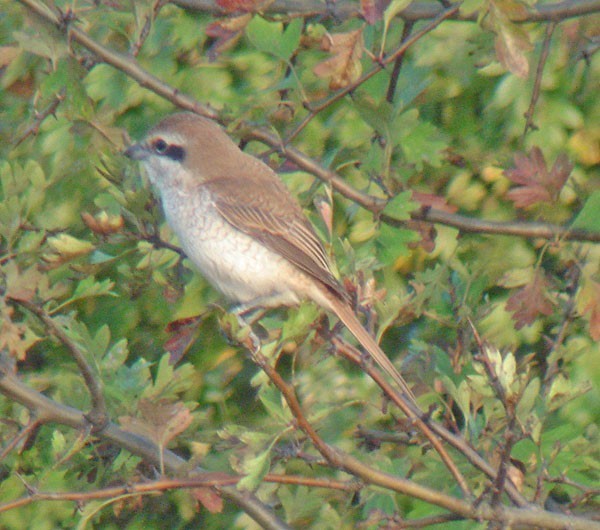
Brown Shrike, Staines Moor, Surrey (Photo: Andrew Moon)
That most charismatic and exciting of all the rare thrushes, White's Thrush, was the star turn over the weekend, although making landfall on Fair Isle managed to preclude hundreds of potential admirers from attending. This beautiful, bulky Zoothera has become more and more frequent in recent years, but twitchable birds remain rare. Fair Isle has now seen at least six birds appear there since the turn of the decade, including three last year, and Shetland as a whole has bagged 15 different birds since the year 2000.
Staying on Shetland, the first-winter Taiga Flycatcher, which was on Fetlar until 5th, was re-found at The Gloup on nearby Yell on 9th — and by one of the original observers from Fetlar (what are the chances of that happening?). In Nottinghamshire, the first-winter Steppe Grey Shrike at Lound GPs was last seen at dusk on 8th, having attracted a steady stream of admirers over the previous few days. In Cork, the county's second American Buff-bellied Pipit of the autumn was found near Mizen Head, at Brow Head, on 11th and the bird at Clahane was still present to 13th. In Highland, a Little Shearwater was reported flying past Duncansby Head at midday on 9th.
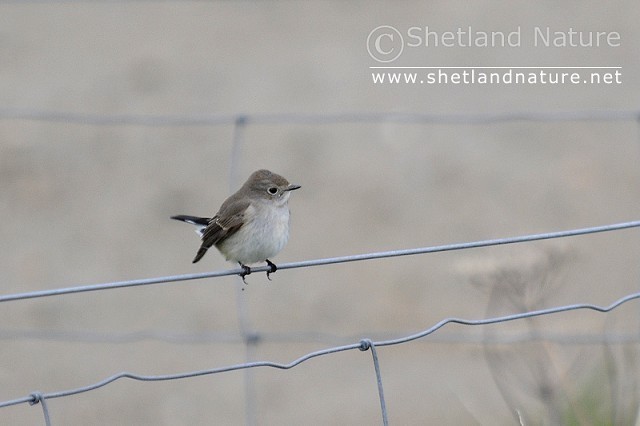
Taiga Flycatcher, Gloup, Yell, Shetland (Photo: Brydon Thomason)
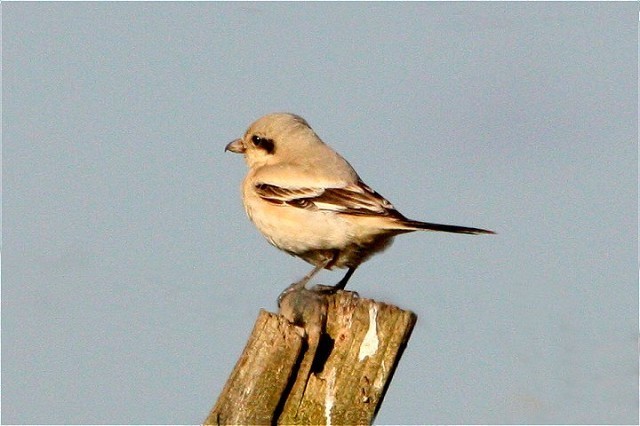
Steppe Grey Shrike, Lound GPs, Nottinghamshire (Photo: Paul Wetton)
By nightfall on 13th, the rumour mill was in overdrive with tales of a Hooded Warbler in the Cot Valley (Cornwall). Stories like this often arise during the autumn, but this felt like one of the classics, harking back to the days when the old-fashioned grapevine went into meltdown and there were no news services to rely upon for information. Unusually, this rumour did make the headlines — but based on what? Nothing, it would seem. Currently there are just two records of this vibrant Wilsonia — the first was seen around Big Pool, St. Agnes (Scilly) from 20th–23rd September 1970, the second was seen at Hirta on St. Kilda on 10th September 1992 and a third isn't close at hand.
Also in Highland, a single Great Shearwater flew past Tarbet Ness on 10th and was the only large shearwater of the week. On 9th, 17 Balearic Shearwaters flew past Porthgwarra (Cornwall) and a further 200 or so were recorded during the rest of the week including 26 off Portland Bill (Dorset) and 52, again off Porthgwarra, on 11th. These totals were swamped though by the count of 91 from Porthgwarra on 12th. Compared to last week, Sooty Shearwaters were in very short supply (barely a double-figure tally anywhere; 39 off the Fife coast in 90 minutes on 9th was the stand-out count). Much the same could be said for Pomarine Skuas: around 50 birds were noted, largely down the east coast, with seven off Landguard (Suffolk) on 9th and seven from Kilcummin Head (Co. Mayo) on 11th the highest counts of the week. Five single Long-tailed Skuas were noted at the start of the week: three were seen in Scotland (at South Queensferry in Lothian, from Hynish, Tiree in Argyll and from Fife Ness) with two off Scarborough (North Yorkshire), one on 8th and one on 9th. On 12th, four juveniles were seen at Cley (Norfolk).
Grey Phalaropes were in short supply; singles in Essex, Aberdeenshire and Highland were followed by two off Cley and four off South Uist (Outer Hebrides) on 11th. Half a dozen Sabine's Gulls included a returning adult at Cobh (Co. Cork), while four Little Auks were seen from Fife Ness on 9th, two more were off Withernsea (East Yorkshire) on the same date and three were seen at Burghead Bay (Moray) on 13th.
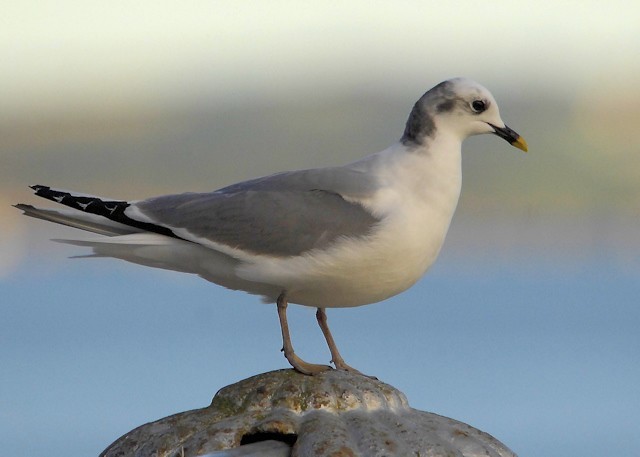
Sabine's Gull, Cobh, Cork (Photo: Ronan mclaughlin)
Numbers of Glossy Ibises continued to fall away this week, but there were still several on offer countrywide. On 8th, Kentish sightings of singles came from Pegwell Bay, Swalecliffe, Stoke and Grain (probably just two birds involved). Elsewhere on the same day, further lonesome birds were still present at Meare Heath (Somerset) and Druridge Bay (Northumberland), while others were seen at Rochford (Essex) and Maxey GPs (Cambridgeshire). The 9th saw Loch of Strathbeg (Aberdeenshire) join the big parade, while the four seen last week on the Somerset Levels appeared at Shapwick Heath (moving to Meare Heath the following day). Also on 9th, a Glossy Ibis reappeared at Diddington Pit (Cambridgeshire). Three birds were still at Dungeness (Kent) on 10th when one was seen flying over Cavenham Heath (Suffolk). On 11th, a single Glossy Ibis was seen over Sandwich Bay (Kent) — perhaps the bird seen at nearby Pegwell on 8th — and another was noted at Pett Levels (East Sussex). Further afield, a Glossy Ibis was again at Tacumshin (Co. Wexford) on 11th, and on 13th the first double-figure flock for weeks appeared at Ballyferriter (Co. Kerry) — 11 birds were seen there. The following day, nine of these flew over Smerwick Harbour, while in England a Glossy Ibis was seen at Severn Beach and New Passage (Glos).
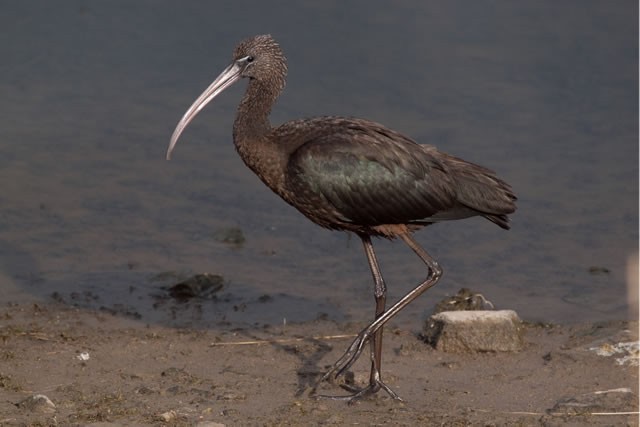
Glossy Ibis, Druridge Pools, Northumberland (Photo: Chris Barlow)
There was no real change in the Cattle Egrets reported this week — three remained around Frampton-upon-Severn (Gloucestershire) to 10th at least and three or four birds were still present around assorted Hampshire marshes and reserves (including two at Titchfield Haven on 10th). One also lingered on Meare Heath throughout much of the week (although two birds were on Shapwick Heath on 11th) and one appeared at Chard Reservoir on 13th. A new bird was seen around Lydd (Kent) on 11th, moving to the nearby RSPB reserve at Dungeness on 12th, and another was on the Hayle Estuary (Cornwall) on 14th.

Cattle Egret, Lydd, Kent (Photo: David Campbell)
The American Egret was still at Rahasane Turlough (Co. Galway) to 10th at least, while its European Great White Egret counterparts included two birds still at Leighton Moss (Lancashire) from 8th–10th at least. Regular singles lingered in Cumbria, Somerset, Hampshire and Suffolk, with new birds noted in Gwynedd (at Porthmadog and the Glaslyn Estuary) and Essex (over Two Tree Island) on 9th. After two birds at Marazion (Cornwall) on 13th, it was the 14th that produced the most extraordinary Great White Egret record ever — a flock of eight seen flying along the north Norfolk coast and last noted flying east from Mundesley at just after 9.30am. An amazing flock, which was matched by a flock of the same size at La Coupe on Jersey, also on the morning of 14th. Singles on 14th were seen in Cornwall, Warwickshire and Lancashire. In Dorset, a sub-adult Purple Heron was a surprise visitor over Lodmoor on 12th.

Great White Egret, Cley Marshes NWT, Norfolk (Photo:
Alex Lees)
Wintering groups of Spoonbills began to build further this week: 15 birds were in the Poole Harbour (Dorset) on 12th and three birds were still at Isley Marsh (Devon) throughout the week. Other notable groups this week included five at Stanpit Marsh (Dorset) on 9th, with another quintet on Kinsale Marsh (Co. Cork) on 10th, when six were seen on the Dinham Flats (Cornwall). Three birds were at Abberton Reservoir on 10th and three were at Wacker Quay (Cornwall) on 11th. On 13th, four Spoonbills were seen on rocks off Sennen Cove (Cornwall) before, presumably, the same birds moved to the Hayle Estuary later the same day. Three Spoonbills were seen over Scilly on 14th. The Common Crane lingered in County Durham for much of the week and a flock of three were seen over Belvide Reservoir (Staffordshire) and Hinckley (Leicestershire) on 8th. On 12th, five Cranes were seen near Eldernell (Cambridgeshire) and singles were reported over Mam Tor (Derbyshire) and Arne (Dorset). The 13th saw three birds circle over Dungeness.

Spoonbill, Timoleague, Cork (Photo: Ronan mclaughlin)

Common Crane, Lamesley, Durham (Photo: Ron Hindhaugh)
A Spotted Crake appeared on the Abbey Pool, Tresco (Scilly) on 8th and the long-staying bird at the WWT Wetlands Centre (London) was seen until 9th. Two birds were at Pennington Marshes (Hampshire) on 14th. A migrant Corncrake was seen at Spurn (East Yorkshire) on 10th.
A white Snow Goose flew over Alkborough Flats (Lincolnshire) on 8th and a blue bird was on Plex Moss (Lancashire) on the same day (appearing on the Alt Estuary the following evening). Then, on 12th, a white Snow Goose was seen in the county, at Hesketh Out Marsh. Confusingly, the blue Snow Goose was on site on 13th with no sign of the white one! Scottish singles remained at Loch of Strathbeg (Aberdeenshire) and in the Aberlady Bay area (Lothian) for most of the week, but what to make of the flock of 31 Snow Geese seen in Lancashire on 11th? First seen just north of Marton Mere, the flock was then noted over Conder Pool and Brockholes Wetland NR and consisted of at least 20 white and seven blue birds. Its a great time of year for wild birds to make an Atlantic crossing but the flock may have "grown" as it headed around the county, suggesting that it may have collected some "local" birds. Until any firm evidence to the contrary appears, maybe these will be given a fair hearing, although some local Lancashire birders are less than complimentary about this flock's vagrancy potential. On Islay, the recently returned wintering Richardson's Canada Goose was still at Loch Gruinart on 9th. The first Black Brants of the autumn appeared at Strangford Lough (Co. Down) on 10th, Leigh-on-Sea (Essex) on 11th and the Fleet (Dorset) on 12th.
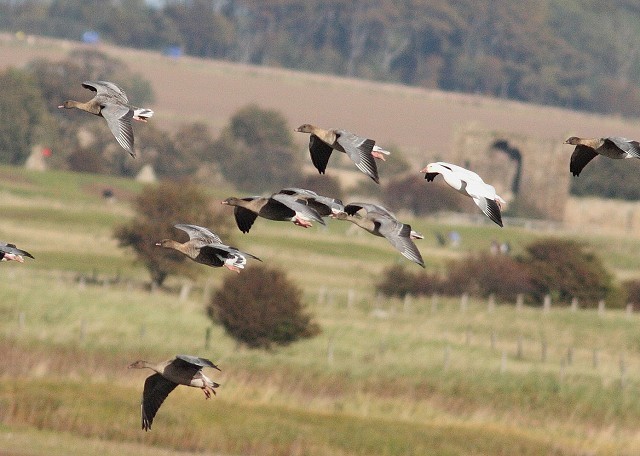
Snow Goose, Aberlady Bay, Lothian (Photo: Brendan Doe)
The drake Green-winged Teal was still to be seen on Siddick Ponds (Cumbria) on 9th–12th and the two Blue-winged Teal reported over recent weeks were still in place this week — the adult female was on Bull Island (Co. Dublin) again on 8th (and 13th) and the drake was again at Saltholme Pools (Cleveland) on 10th. In Ireland, a drake American Wigeon was still on The Gearagh (Co. Cork) on 11th and on 13th two separate drakes were found in Dumfries & Galloway, at Castle Loch and Mersehead. The 14th saw the arrival of a female American Wigeon on the Hayle Estuary.

Green-winged Teal, Siddick Ponds NR, Cumbria (Photo: Craig shaw)
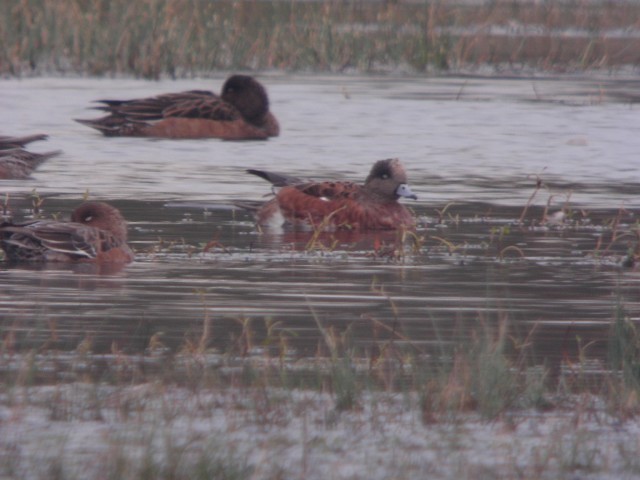
American Wigeon, Mersehead RSPB, Dumfries & Galloway (Photo: Paul R Massey)
In Warwickshire, the drake Lesser Scaup was still on Draycote Water from 8th–14th, and in Glamorgan another drake returned to Cardiff Bay on 11th. In Staffordshire, the drake Ring-necked Duck remained for another week on Westport Lake and the returning, wintering drake was back at Foxcote Reservoir (Buckinghamshire) on 11th. Another bird back on familiar territory was the drake seen on Loch of Tingwall (Shetland) on 11th. A first-winter drake was found at Lochwinnoch (Clyde) on 8th and the drake at Cheddar Reservoir (Somerset) was still present on the same date, moving back to Blagdon Lake on 10th. Almost within a stone's throw of Blagdon is the regular drake Ferruginous Duck, still bobbing around on Chew Valley Lake in the early part of the week, and the 14th saw the drake reappear at Calvert Lakes reserve (Buckinghamshire).
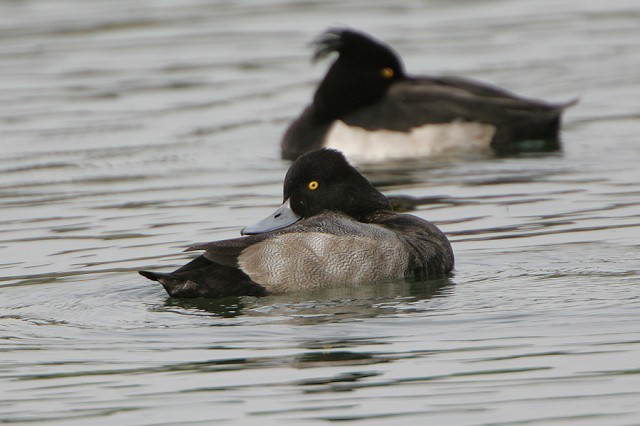
Lesser Scaup, Draycote Water, Warwickshire (Photo: Dave Hutton)

Ring-necked Duck, Westport Lake, Staffordshire (Photo: Mr J Davenport)
The eclipse drake King Eider was still finding The Wash to its liking, still showing at Cut End (Lincolnshire) until 9th. Down in Dorset, the drake Hooded Merganser was still at Radipole Lake on 9th, and in Cleveland the female moved to Hemlington on 12th.
There were two Snowy Owls to report on this week, both familiar individuals: the male was still at Mangurstadh, Lewis (Outer Hebrides) on 8th and the female was still on Termon Hill (Co. Mayo) to 10th. A white Gyrfalcon was noted some 50 miles west of Shetland, on the BP Clair oil platform for several days prior to 11th. A Rough-legged Buzzard was at Shuart (Kent) on 12th.
Two American Golden Plovers were found on Cape Clear Island (Co. Cork) on 9th and a juvenile was at Boddam (Shetland) on the same date. Elsewhere, the juveniles remained at Inchydoney Bay (Co. Cork) to 8th and Grindigar (Orkney) to 11th, while adults were still in Smerwick Harbour (Co. Kerry) on 9th and on Tiree to 13th (with two birds again at Sandaig on 14th). A new adult was found at Baleshare, North Uist (Outer Hebrides) on 10th, and on 11th at least two more new birds appeared. One was at Leasowe Lighthouse (Cheshire) — with perhaps the same bird appearing later at Seaforth (Lancashire) — while another was seen at Guardbridge (Fife). On 13th, an adult American Golden Plover was found on the Deerness peninsula on Orkney.

American Golden Plover, Tiree, Argyll (Photo: Jim Dickson)
The juvenile Long-billed Dowitcher on Tresco (Scilly) was still present from 8th and a single juvenile was again at Inner Marsh Farm (Cheshire) on 9th–10th. A new juvenile Long-billed Dowitcher was found at Ibsley Water, Blashford Lakes (Hampshire) on 11th, and on 12th two birds were at Banks Marsh (Lancashire), with one the following day near Cockersand Abbey, also in Lancashire. This bird remained to 14th and two more Lancashire birds were seen again at Banks Marsh, before flying off, at around 3pm. Then, later in the afternoon, two birds were again at Inner Marsh Farm. Just how many are there in the northwest? On South Uist (Outer Hebrides), a Long-billed Dowitcher was seen again at Howmore, also on 14th.

Long-billed Dowitcher, Blashford Lakes HWT, Hampshire (Photo: Richard Ford)
A juvenile Spotted Sandpiper was found at Quendale Burn (Shetland) on 11th, moving later to Garths Ness: only the seventh for the islands. A Baird's Sandpiper was reported from Carse Bay (Dumfries & Galloway) on 8th and another was at Lound GPs (Nottinghamshire) late on 14th. There's just one previous accepted record of Baird's Sandpiper in Notts: that one was also at Lound in the summer of 1998. The only White-rumped Sandpipers this week were lingering singles at Loch of Strathbeg and Abberton Reservoir (Essex). The latter site (enjoying a decent run of things recently) also played host to a Pectoral Sandpiper this week, one of a dozen or so seen around Britain and Ireland this week. Two birds remained at Meare Heath in Somerset, two were again at Blithfield Reservoir (Staffordshire) on 9th and two were on the Amble Marshes (Cornwall) on 11th.
Just four Buff-breasted Sandpipers were noted during the last seven days. Singles remained at Cresswell Pond (Northumberland) to 8th and another lingered at Saltholme Pools (Cleveland) from 8th–13th. New birds were reported at Winteringham (Lincolnshire) on 8th and West Runton (Norfolk) on 11th. Inevitably, the Lesser Yellowlegs at Aberlady Bay (Lothian) was present throughout the week.
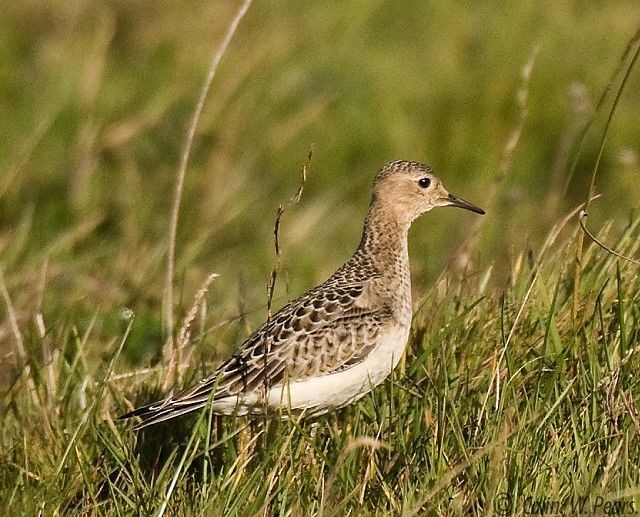
Buff-breasted Sandpiper, Cresswell Pond NWT, Northumberland (Photo: Colin Pears)
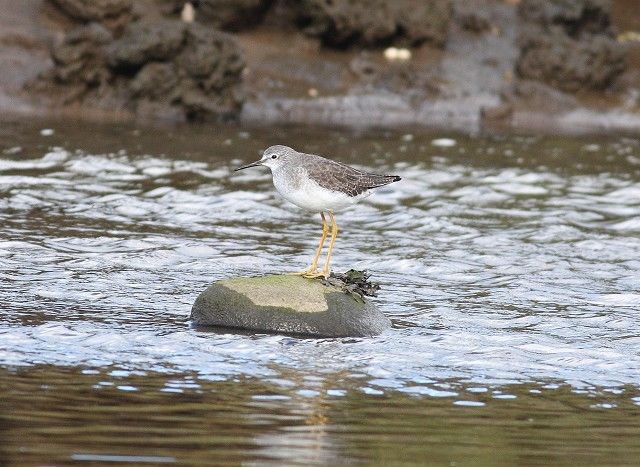
Lesser Yellowlegs, Aberlady Bay, Lothian (Photo: Brendan Doe)
There were two double-act Dotterels this week: two at Brandon Point (Co. Kerry) on 8th were followed by another duo at Porthgwarra on 9th, while on 11th a single bird was heard flying over Trisant (Ceredigion). A single Dotterel was at Leam Lough (Co. Mayo) on 12th. In Cambridgeshire, a Pacific Golden Plover was reported briefly at Stretham on 11th.
The striking adult Azorean Atlantic Gull was still around the pools and pits around Didcot (Oxfordshire) until 14th and began to generate the interest it so rightly deserves (it is a second for Britain after all!). On 11th, a stunning, diminutive adult Baltic Gull was found by the same ultra-sharp-eyed birder who found the rather more brutish atlantis at Didcot. Whatever is he going to turn up next?! A second-summer Laughing Gull was photographed on Coll (Argyll) on 10th while Ring-billed Gulls included nine birds in Ireland (two in Clare, two in Derry and one each for Antrim, Cork, Dublin, Galway and Mayo) while it was one each for Cornwall, Hampshire (a second-winter at Ibsley Water on 11th), Lancashire and Argyll.
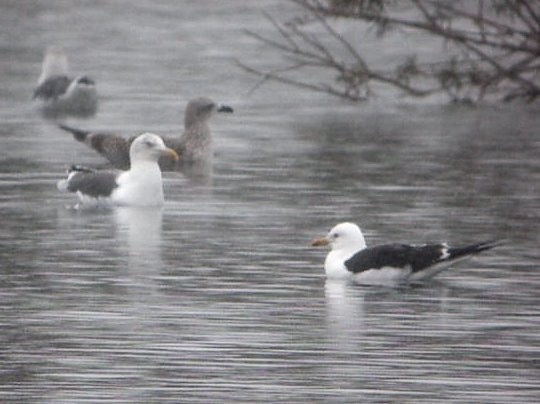
Baltic Gull, Didcot, Oxfordshire (Photo: Adam Hartley)

Laughing Gull, Coll, Argyll (Photo: Simon Wellock)

Ring-billed Gull, Spanish Point, Clare (Photo: Jeffcop)
Both Iceland Gull and Glaucous Gull barely troubled the scorer (four of the former, two of the latter) so it's swiftly on to Caspian Gull. Two first-winters and a third-winter were at Blackborough End tip (Norfolk) on 9th and two first-winters were seen at Didcot on the same date. Single first-winters (presumably Didcot birds) were seen at Farmoor Reservoir on 9th and 10th, with a third-winter there on 14th. Elsewhere, single Caspian Gulls were seen in Cambridgeshire, Kent, Somerset, South Yorkshire and, most notably, on the Cowloe, Sennen Cove (Cornwall) on 14th. In Ireland, a Forster's Tern made its regular call to Cruisetown Strand (Co. Louth) on 11th — the bird has been seen here each October since 2006, but it doesn't always hang around for too long.
Two new Pechora Pipits on the mainland this week took the Shetland tally to double figures for the autumn: one was found at Scalloway on 8th and another was reported at Veensgarth on 11th. Two of last week's birds hung on for a few more days: one at Sandgarth remained to 8th and another was on Out Skerries until 11th at least. An Olive-backed Pipit was found at Sullom (Shetland) on 8th and two were at Kergord Plantation on 9th, one remaining to 11th. The same date also saw an Olive-backed Pipit appear on Whalsay. Away from the Shetland domination, another Olive-backed Pipit was found at Mangurstadh, Lewis on 9th.

Olive-backed Pipit, Vats-Houll, Whalsay, Shetland (Photo: Jason Atkinson)
Fifteen Richard's Pipits were seen during the week (one was on Fair Isle, another in East Yorkshire, while two were on the Farnes and Scilly, three were in Norfolk and up to six birds were in Cornwall, including two at Nanjizal on 12th). A Tawny Pipit on St. Agnes (Scilly) caused a few headaches on 9th–10th. Some birders watching this bird also had a flyover Red-throated Pipit on 10th. Another Scilly Red-throated Pipit was on St. Martin's on 11th when, way, way off to the north, another was seen in the garden at Gloup on Yell, where the Taiga Flycatcher was lurking. Lurching back to Scilly, another Red-throated Pipit was reported from St. Mary's on 12th and another was reported at Rainham Marshes (London) on 13th. On 14th a Red-throated Pipit was at Easington (East Yorkshire) and one was reported over the Brown Shrike site at Staines Moor.

Tawny Pipit, St. Agnes, Isles of Scilly (Photo: Mark Pearson)
Norfolk (ahhh, the slumbering behemoth that is Norfolk!) pitched up with a couple of Short-toed Larks across the weekend of 10th–11th — one was on the far tip of Blakeney Point on the former date and a more accessible bird was at West Runton on the latter. A third Norfolk bird was found in stubble behind Walsey Hills, near Cley, on 14th, when another was seen on Fair Isle. Staying on Shetland, the first (Bohemian) Waxwing of the autumn was seen over Scatness, Mainland on 11th.
The Wryneck at Lathbury (Buckinghamshire) was still present on 8th and four or five singles followed on Scilly, with others noted at Porthgwarra, Land's End and St. Levan (Cornwall) and Hope Point — two here on 14th — and Hildenborough (Kent). A Hoopoe was at Trearddur Bay (Anglesey) on 11th, with perhaps the same bird seen briefly at Soldier's Point on 14th, and another Hoopoe was seen at Isley Marsh (Devon) on 13th.

Wryneck, Hope Point, Kent (Photo: Steve Ray)
Bluethroats this week included at least six singles around Shetland on 11th: three on Mainland and singles on Out Skerries, Fetlar and Unst (perhaps two birds here). Three were seen on Fair Isle on 10th, while on 12th singles were at Graven on the Mainland and at Balatsound on Unst. Also on 12th, a Bluethroat arrived on Orkney, on North Ronaldsay.

Bluethroat, Graven, Mainland, Shetland (Photo: Rob Fray)
Back on Shetland (where else?) the first Red-flanked Bluetail of the year was found at Sandgarth on 12th. Still present to 14th, this species is still one to send a wee shiver down the spine of any self-respecting birder. And mainland listers had their first chance of a Bluetail on 14th, when one was found at Minsmere (Suffolk).

Red-flanked Bluetail, Sandgarth, Mainland, Shetland (Photo: Rob Fray)
Still on Shetland, a Black-throated Thrush was reported from bushes in the lighthouse garden at Sumburgh at the southern tip of Mainland on 14th. Redwing is never a species you'd normally see in the Weekly Review but special mention must go the count from The Pinnacle, Sandy (Bedfordshire) on 13th: 32,988 were counted from dawn to dusk, with nearly 30,000 seen by midday (with several other sites around the country recording four figures on the same date).

Redwing, Sammy's Point, East Yorkshire (Photo: Mark Coates)
Norfolk clocked up another Pied Wheatear for the county list on 14th when a first-winter female appeared at Horsey. The tally is now on 11, but this is the first since two birds in the autumn of 2003, including a male found at nearby Waxham (and it's exactly 10 years to the day since the male Pied Wheatear appeared at Choseley).
In Cornwall, the juvenile Woodchat Shrike at Nanquidno was last reported on 8th, while Red-backed Shrikes appeared at Corfe Castle (Dorset) and Easington (East Yorkshire) on 8th, and St. Martin's (Scilly) and the Farne Islands (Northumberland) on 10th. The Great Grey Shrike on Thorne Moors (South Yorkshire) was still present to 10th at least and another was found on Orkney, at Sandside Bay, Mainland on 10th. Further singles followed at Cut End (Lincolnshire) on 11th and at Holme (Norfolk) on 13th–14th (with another seen flying over nearby Hunstanton on 14th).

Great Grey Shrike, Thorne Moors NNR, South Yorkshire (Photo: Rob Smallwood)
A Paddyfield Warbler was reported from St. Mary's (Scilly) on 9th (though news of the bird's presence didn't emerge until after dark on 10th) and, if accepted, will be the fifth on the islands this decade. On Shetland, a Lanceolated Warbler was found on Out Skerries on 11th (a lean year to date for this charismatic little Locustella) although this week saw the balance trying to be redressed — on 12th, further singles were found at Baltasound, on Unst, and North Ronaldsay (Orkney).

Lanceolated Warbler, Baltasound, Unst, Shetland (Photo: Brydon Thomason)
The River Warbler was still on Fair Isle until 12th while the 11th saw Shetland's fifth Blyth's Reed Warbler in ten days or so appear at Hoswick, on Mainland. Also on Shetland, and also on 11th, was a Marsh Warbler, found at Quendale. A Booted Warbler in the valley at Nanquidno (Cornwall) on 13th may actually have been at the root of the Hooded Warbler story — a misheard name leading to Chinese whispers leading to an hour or two of after-dark mayhem! On Scilly, a Melodious Warbler was on St. Agnes on 14th.
A first-winter Subalpine Warbler was on Bardsey Island (Gwynedd) on 10th–11th, the sixth for the island since the end of October 2002. One or two Barred Warblers were along the coast of north Norfolk this week (one was suppressed, one wasn't) and four were seen on Shetland, at Sandwick on 8th, Skaw, Whalsay on 10th, Fetlar on 11th and Eswick on 12th. At least two birds were also noted in East Yorkshire (at Spurn). In Kent one was at Hope Point and others made it over to Barra and Lewis during the week. Another made it to Valentia Island (Co. Kerry) on 13th, when another was seen at Torness (Lothian).
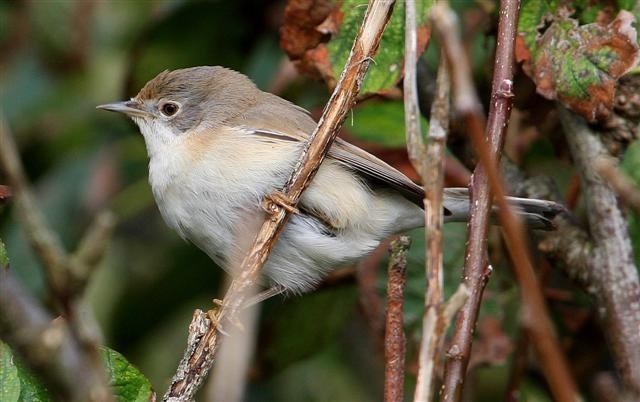
Subalpine Warbler, Bardsey Island, Gwynedd (Photo: Steve Stansfield)
A super-looking Western Bonelli's Warbler (the first in 2009) was found at Bigton (Shetland) on 10th and a Bonelli's Warbler sp. (possibly an Eastern) was reported on St. Mary's (Scilly) on the same day. Another first for the year to appear on 10th was Radde's Warbler and no fewer than six birds were found during the day. First was one trapped and ringed at Druridge Pools (Northumberland) and was quickly followed by birds at Sammy's Point (East Yorkshire), Helvick Head (Co. Waterford), Sandwich Bay (Kent) — another trapped bird, at Filey (North Yorkshire and — the county's second of the day — on Holy Island (Northumberland). The seventh of the weekend appeared at Flamborough Head (East Yorkshire) on 11th. On 13th, the ringed Radde's Warbler reappeared again at Sandwich Bay and on 14th, one was found on St. Martin's (Scilly).

Western Bonelli's Warbler, Ellister, Mainland, Shetland (Photo: Steve Minton)

Radde's Warbler, Sandwich Bay, Kent (Photo: Colin Fisher)
Shetland's tenth Arctic Warbler of the autumn was reported in the Kergord Plantation on 11th and two were still at Wester Quarff on 8th–9th, with one still there to 12th at least. In Cork, an Arctic Warbler was found in Cotter's Garden, Cape Clear Island on 9th and was still present to 14th, the first in Ireland since one in Donegal in 2003.

Arctic Warbler, Cape Clear, Cork (Photo: Graham Clarke)
After what have been a couple of rather spartan weeks for Yellow-browed Warblers, the autumn finally got itself up and running with some 150 birds noted through the week. Some 35 or so were noted on 8th, including up to seven in Kent and eight on Fetlar, and a further 20 new individuals were found on 9th, including at least three at Minsmere (Suffolk). The 10th, being a Saturday, was a big day for Yellow-browed Warblers — at least 70 new birds were found, many of them along the east coast, from Aberdeenshire to Essex. At least eight birds were in Norfolk, seven were in Lincolnshire, six were seen around the Spurn peninsula while Flamborough Head (East Yorkshire) and Holy Island (Northumberland) scored five each. At least six were also seen on Scilly. The 11th saw 12 birds reported from Kergord Plantation on Shetland, another eight on Fetlar and at least a further half dozen reported around the islands. In Northumberland, three Yellow-browed Warblers were on St. Mary's Island and four more were at Low-Newton-by-sea. Half a dozen birds were counted on Flamborough Head on 12th and on 13th, as birds continued to arrive, a singing male was found at Kilnsea (East Yorkshire). Five Yellow-browed Warblers were on Cape Clear on 14th — a day with around 50 birds to its name.
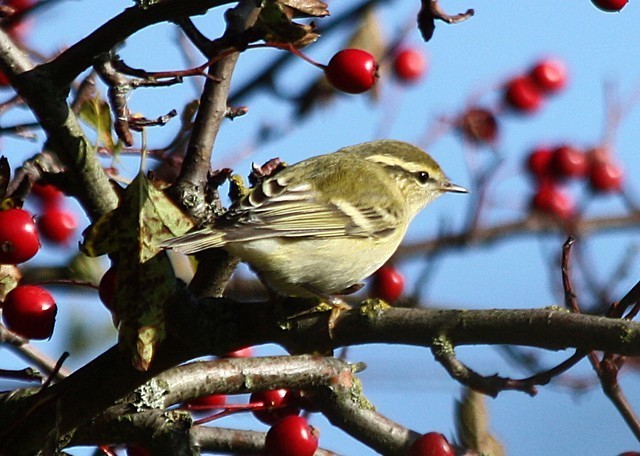
Yellow-browed Warbler, Holy Island, Northumberland (Photo: Willie McBay)
And the very same site on the very same day also produced the autumn's first guaranteed Pallas's Warbler, following on from a mysterious report of one in Dorset in mid-September. Hopefully the Kilnsea bird is the first of many more to come over the next six to eight weeks.
Three or four Red-breasted Flycatchers were on Scilly (on Bryher, St. Agnes and St. Mary's) between 8th and 12th and Shetland also claimed up to four birds: one was on Mid Yell on 8th and two more were found on 11th — at Kergord and Garths Ness (did anyone do the "on the day" Taiga/RbF double on 11th?) The fourth of the week was at Channerwick on 12th with another Shetland bird reaching Out Skerries on 13th. Another island Red-breasted Flycatcher was seen on the Farnes on 10th, while mainland singles were seen at Sizewell (Suffolk) and Wells Woods (Norfolk) on the same day, and at Dungeness on 13th and Holy Island on 14th.

Red-breasted Flycatcher, Holy Island, Northumberland (Photo: Ron McCombe)
Norfolk popped in a couple of juvenile Rose-coloured Starlings on 11th: one was seen flying over West Runton, before reappearing near Beeston Bump later the same day, and another was found at Choseley (the latter bird was then seen around the surrounding area, down to Thornham and Titchwell the following day). Elsewhere, another juvenile remained on St. Agnes (Scilly) from 8th–12th with one or two more on St. Mary's on 12th and 14th, and one was at Land's End (Cornwall) on 13th. Two Penduline Tits were reported at the Cardiff Bay Wetlands (Glamorgan) on 14th, but subsequent searches yielded nothing.
On Fair Isle, a Rustic Bunting was found on 14th, while at least two Little Buntings were seen there during the week (with another at Sumburgh on 11th). Another Little Bunting paid a brief visit to Portland Bill on 8th and Scilly singles were on St. Agnes on 9th, St. Mary's on 11th and 14th and St. Martin's on 13th–14th. Also on 11th, in Dorset, an Ortolan Bunting was reported at Middlebere. After a busy week last week, this week was rather quieter in terms of numbers of Common Rosefinches — just six birds were noted. One was on Barra (Outer Hebrides) from 8th–12th, singles in Shetland were seen on Out Skerries (on 9th), Unst (on 11th) and Mainland (on 13th), while on Orkney one was on North Ronaldsay on 12th. In Ireland, a Rosefinch was at Mizen Head (Co. Cork) on 14th.

Little Bunting, St. Mary's, Isles of Scilly (Photo: anon)
Several Hornemann's Arctic Redpolls continued to be seen around Scottish islands this week. One was still on North Ronaldsay (Orkney) on 8th, and on 10th new birds were found on the Outer Hebrides: two were on Lewis and a new bird was on Barra (with one on North Uist and two on Barra on 14th). Most of these fluffy-looking white orbs were still to be found on Shetland though — on 8th, single Mainland birds were at Voe and Aith, one was still on Unst and two were found on Out Skerries. On 11th, further new arrivals were at Funzie on Fetlar, and at Mid Yell, and on 13th, two were together at Saxa Vord on Unst.

Arctic Redpoll, Mid Yell, Yell, Shetland (Photo: Rob Fray)
The review concludes with the year's first Blackpoll Warbler, found at Garinish Point in County Cork on 11th and still present to 14th. The fifth county record, this Blackpoll was Cork's first since one on Dursey Island on October 10th 2006 (the first three were all on Cape Clear). It is also exactly a year ago that the same site was drawing admirers from far and wide when a Scarlet Tanager was in semi-residence.

Blackpoll Warbler, Garinish Point, Cork (Photo: Graham Clarke)
Photo of the Week

Common Kestrel, Ipswich, Suffolk (Photo:
Amanda Hayes)
There are now so many photographers chasing so many birds that it has become extremely difficult to capture a unique image. If you spend enough hours in the field, though, you will eventually see a sight that no-one has seen before or will ever see again. This week, Amanda Hayes may well have witnessed - and captured - one such event as a dragonfly landed on a Common Kestrel at the moment it disgorged a food pellet. Although this wacky combination is not necessarily one that anyone would ever set out to shoot, it certainly makes for a memorable image. Just try looking at it without raising your eyebrows and shaking your head!
Other notable photos

Black Skimmer, United States (Photo:
Kevin Du Rose)

Red Kite, Gigrin Farm, Powys (Photo:
Chris Upson)

Little Egret, Leighton Moss RSPB, Lancashire (Photo:
David Cookson)

Sparrowhawk, Cley Marshes NWT, Norfolk (Photo:
Amanda Hayes)

Black-tailed Godwit, Leighton Moss RSPB, Lancashire (Photo:
Jackie Moreton)

Great Crested Grebe, Pitsford Reservoir, Northamptonshire (Photo:
John Betts)

Jay, Wollaton Park, Nottinghamshire (Photo:
Sean Browne)

Rook, Ipswich, Suffolk (Photo:
Richard Bedford)

Green Woodpecker, North Wirral, Cheshire (Photo:
Richard Steel)

Blue Tit, undisclosed site, Worcestershire (Photo:
Mark Hancox)

Mallard, Cleethorpes, Lincolnshire (Photo:
Matt Latham)

Sanderling, Titchwell RSPB, Norfolk (Photo:
Andy Shepherd)

Common Kingfisher, undisclosed site, Northamptonshire (Photo:
Richard Bedford)

Spotted Redshank, Leighton Moss RSPB, Lancashire (Photo:
David Moreton)

Gannet, Bridlington RSPB Skua Cruise, East Yorkshire (Photo:
Maddox)

Long-tailed Tit, Minsmere RSPB, Suffolk (Photo:
Jon Evans)

